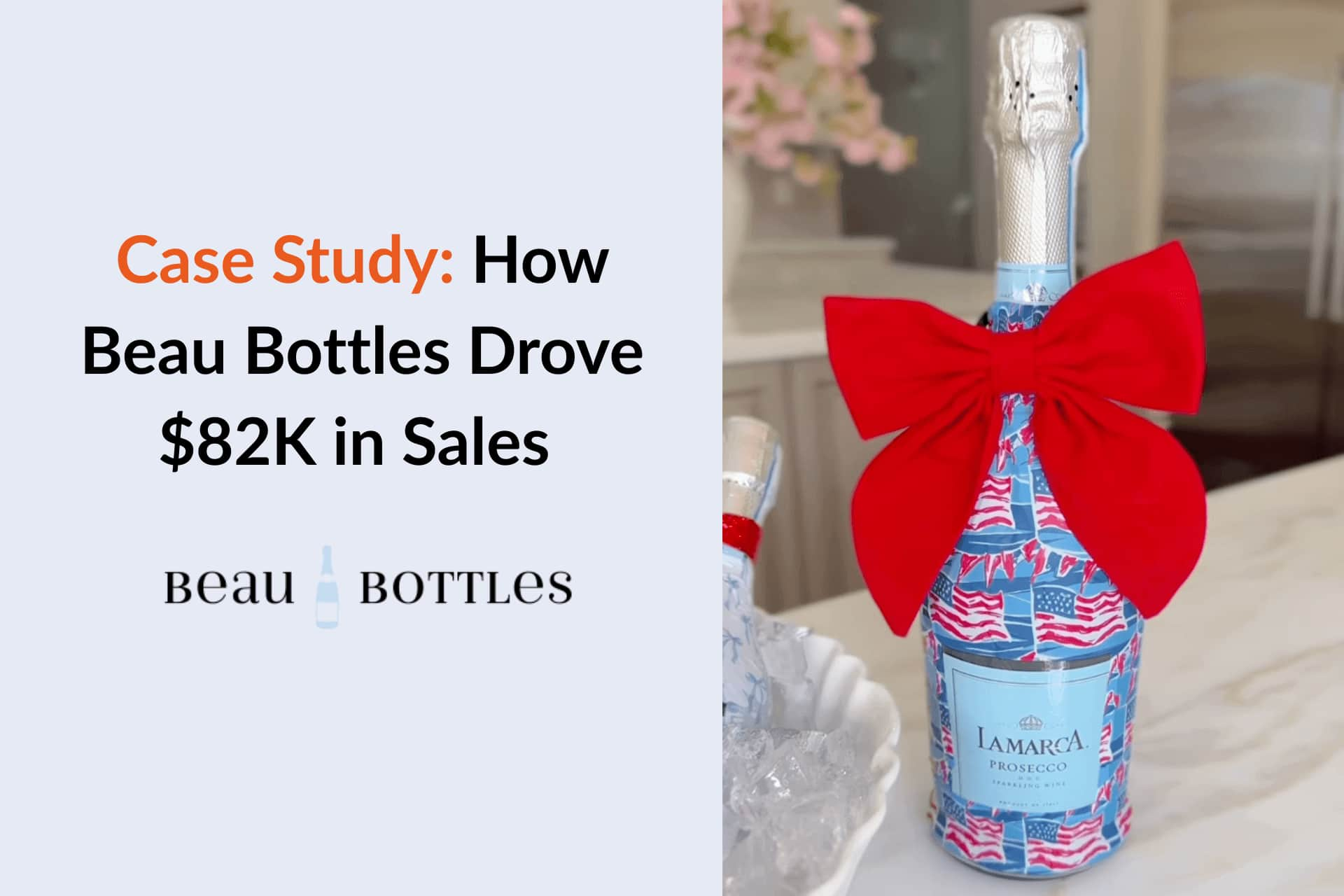





Finding the right influencer marketing platform can be the difference between scaling campaigns effectively and wasting time on manual outreach. While Dreaminfluence has gained some traction, many D2C marketers report recurring issues, limited creator discovery filters, lack of in-depth performance analytics, and difficulties integrating with eCommerce storefronts like Shopify and WooCommerce. As a result, brand owners and agencies are actively looking for alternatives that offer more robust features, faster workflows, and better ROI tracking.
In this article, we’ll compare the top 10 leading alternatives to Dreaminfluence, analyzing features, pricing, and real user reviews to help you choose the right platform for your influencer marketing stack.
Here are the top 10 Dreaminfluence alternatives we’ll explore in this article:
Here are 3 specific reasons why users are actively searching for Dreaminfluence alternatives:
Several Reddit creators warn against over-relying on platforms like Dreaminfluence, which can hinder brand control and creator independence. Since platforms often take a cut of revenue and mediate the brand - creator relationship, users find themselves “at the mercy of the algorithm,” with limited ability to build lasting direct partnerships.
Dreaminfluence does not offer a free trial or a free version of its platform, which can be a major drawback for small businesses or first-time users. Unlike many of its competitors, Dreaminfluence requires users to sign up for a paid plan with no option to test the service beforehand.
According to customer reviews, Dreaminfluence has been described as overpriced, misleading, and operating with unethical practices. The platform reportedly locks users into a minimum six-month contract with auto-renewal clauses that require cancellation three months in advance. Promises of organic engagement and platform support were allegedly unmet, with the only solution offered being manual influencer outreach.
Our comparison focuses on several key aspects:

Platform Coverage: Instagram and TikTok.
Best For: Dreaminfluence is best for eCommerce brands using Shopify or WooCommerce that want to manage influencer campaigns through voucher‑based tracking and automated discount code workflows.
Pricing: Dreaminfluence offers four subscription tiers (billed annually).
Reviews: 3.4 / 5.0 (Trustpilot)
Ease of Use (UX/UI): Users consistently praise Dreaminfluence’s straightforward UI, campaign setup, voucher creation, and content tracking are intuitive, especially for brands using Shopify/WooCommerce. However, more advanced workflows can feel clunky without onboarding support.
Customer Support: Users note that customer service is responsive during onboarding and integration phases, especially for voucher and Shopify connection support. Some complaints mention slower response times for custom feature requests or mid-campaign troubleshooting.

Platform Coverage: Instagram, TikTok, YouTube, Facebook, Pinterest, Snapchat, X, Twitch
Best For: Perfect for fast-scaling D2C brands and eCommerce teams looking to streamline influencer seeding, boost ROI with data-backed campaigns, and run automation-heavy workflows without the need for large in-house teams.
Pricing: (Plans are monthly and scalable.)
Reviews: 5.0 / 5.0 (Capterra)
Ease of Use (UX/UI): Influencer Hero is praised for its clean, beginner-friendly interface that allows users to launch campaigns quickly. With automated flows, customizable outreach templates, and a well-organized dashboard, teams can manage everything from discovery to payment with minimal friction. Its intuitive design eliminates long onboarding or complex setup processes.
Customer Support: Influencer Hero delivers high-touch support, including 24/7 live chat, responsive email help, and access to a dedicated account manager from day one. Users on higher-tier plans benefit from exclusive strategy sessions, Slack channel access, and a comprehensive knowledge base to troubleshoot or plan campaigns more effectively.
Dreaminfluence focuses on Instagram and TikTok with a strong presence in the European market, offering a solid gifting-based workflow and a vetted pool of 18,000+ micro-influencers. In contrast, Influencer Hero supports eight platforms, including YouTube, Facebook, and X, making it a better fit for global, multi-channel influencer campaigns with more advanced automation and reporting tools.
Dreaminfluence requires annual contracts starting at €810/month plus onboarding, while Influencer Hero offers flexible monthly plans starting at $649/month with no mandatory onboarding fee. This makes Influencer Hero more accessible for brands that need to scale quickly without long-term commitments.

Platform Coverage: Instagram, TikTok, YouTube, Facebook, Pinterest, X, Snapchat, Reddit.
Best For: Traackr is best suited for enterprise-level brands and global marketing teams that prioritize data-driven decision-making, influencer ROI analysis, and detailed budget optimization. It’s especially valuable for companies running multi-region campaigns that need to benchmark performance at scale.
Pricing:
Reviews: 4.3 / 5.0 (G2)
Ease of Use (UX/UI): While Traackr offers a sleek and structured interface, it comes with a learning curve due to its analytics-heavy feature set. Users often find the initial setup complex, but once familiar, the platform runs efficiently and provides clear workflows for campaign management.
Customer Support: Traackr is widely recognized for its high-caliber customer success team, offering strategic onboarding, fast responses, and ongoing campaign guidance. While support is generally excellent, some users report technical hiccups and platform lags, which can impact time-sensitive tasks.
Traackr is built for global enterprises that need robust analytics, ROI tracking, and campaign benchmarking. Starting at $32,500/year, it offers tools like the Brand Vitality Score, cost-per-metric dashboards, and real-time performance tracking. It's ideal for large-scale, data-driven teams but may be too complex or costly for smaller brands.
Dreaminfluence, by contrast, is a gifting-focused platform tailored for managing micro-influencer campaigns, especially in Europe. With plans starting at €810/month (~$880), it provides integrated CRM, AI-powered influencer scoring, 1st-party data, Shopify integration, and 24-month content rights. Traackr is better suited for enterprise-level performance marketing, while Dreaminfluence offers a more affordable, hands-on solution for brands prioritizing content and relationship building.

Platform Coverage: Instagram, TikTok, YouTube, X , Twitch, Pinterest, WordPress blogs.
Best For: Ideal for eCommerce brands selling on Shopify or Amazon looking to scale both influencer and affiliate marketing programs with an all-in-one platform.
Pricing: Upfluence offers annual contracts with the following pricing.
Reviews: 4.6 / 5.0 (G2)
Ease of Use (UX/UI): Users generally appreciate the clean UI and powerful automation tools, especially for outreach. However, new users often report a moderate learning curve, particularly during initial setup and onboarding.
Customer Support: Upfluence offers reliable and responsive support, with onboarding help and campaign strategy guidance included. Some users have noted that support is more helpful once the platform is fully set up.
Dreaminfluence focuses heavily on gifting-based campaigns with verified micro-influencers in Europe, while Upfluence caters more toward eCommerce brands with sales operations on Shopify or Amazon, offering advanced affiliate tracking and payout tools.
In terms of pricing, Dreaminfluence starts at €810/month ($880), with a cap of 100 influencers on the highest fixed-tier plan. Upfluence is significantly more expensive, starting at $1,276/month (billed annually), but includes advanced integrations and unlimited influencer outreach with no extra fees.
Dreaminfluence is better for mid-sized brands wanting hands-on support and high-quality content creation, while Upfluence suits growth-stage and enterprise eCommerce brands ready to scale globally with more automation and performance attribution tools.

Platform Coverage: Captiv8 supports influencer campaigns across Instagram, YouTube, TikTok, Facebook, Twitter, and Pinterest.
Best For: Captiv8 is ideal for large-scale enterprise brands seeking robust influencer discovery, campaign management, and analytics at scale. It's especially useful for companies looking to integrate creator commerce features like affiliate programs and storefronts.
Pricing:
No monthly or customizable plans are available; pricing is rigid and enterprise-focused
Reviews: 4.6 / 5.0 (G2)
Ease of Use (UX/UI): Users appreciate the ability to manage multiple campaigns and creators in one place, with tools like drag-and-drop reporting and team-wide collaboration features. However, some users report a learning curve due to the platform’s depth and enterprise-level complexity.
Customer Support: Customer support is a major concern for many users. There are multiple reports of delayed responses and unresolved issues from both brands and creators, particularly related to payment and account management.
Dreaminfluence is built for small to mid-sized brands, especially eCommerce teams in Europe focused on gifting-based influencer campaigns and integrated CRM workflows. It offers native first-party data from TikTok and Instagram, simple AI-driven scoring and discovery, and 24-month content usage rights, with flexible pricing starting at €810/month.
Captiv8, in contrast, caters to large enterprises looking for deep data, competitive intelligence, and robust campaign tracking with integrations into analytics tools like Looker Studio. Its features go far beyond gifting, including affiliate programs and creator storefronts—but come at a steep price with minimal flexibility.
Dreaminfluence starts at approximately €9,720/year with flexible tiers, while Captiv8 requires a $25,000/year minimum plus an additional $3,000 onboarding fee and optional $20K–$30K monthly add-ons. Dreaminfluence is ideal for growing brands seeking simplicity and affordability, while Captiv8 is suited for enterprise teams with larger budgets and complex campaign needs.

Platform Coverage: Instagram, TikTok, YouTube, Facebook, Pinterest, Twitch, X.
Best For: CreatorIQ is best suited for large global brands and agencies looking for a powerful, end-to-end influencer marketing solution with deep analytics, real-time data, and strong CRM and reporting capabilities. Ideal for teams needing scale, structure, and reliable platform integrations.
Pricing:
Reviews: 4.6 / 5.0 (G2)
Ease of Use (UX/UI): Users report the platform is feature-rich with a modern interface, but requires onboarding to use effectively due to its complexity. Custom dashboards, drag-and-drop reporting, and built-in creator sheets enhance user experience once familiar.
Customer Support: Support is a key highlight: every account receives a dedicated implementation manager and customer success team. Users appreciate strategic planning support, hands-on onboarding, and quick access to new features via strong platform partnerships
Dreaminfluence is tailored for smaller brands and eCommerce teams focused on gifting campaigns and CRM-style influencer management, with pricing that starts under €10,000/year. Its all-in-one flow, is powered by human support from micro-influencers and includes flexible AI scoring and affiliate capabilities built into every plan.
CreatorIQ, on the other hand, is engineered for scale. With a client roster that includes Disney and Lululemon, the platform provides unmatched depth in influencer discovery, CRM, payments, and analytics. It relies on direct API integrations for accurate data, and offers strategic support from a dedicated team.
Dreaminfluence starts at €810/month with all features included, while CreatorIQ’s plans begin at $35,000/year with additional fees for advanced modules like Creator Connect. Choose Dreaminfluence for cost-effective, gifting-led campaigns; opt for CreatorIQ if you need enterprise-level analytics, reliability, and structure.

Platform Coverage: Instagram, TikTok, YouTube, Twitch, X (Twitter), Snapchat
Best For: HypeAuditor is best suited for data-driven brands and agencies looking for deep influencer vetting, AI-powered discovery, and robust campaign tracking. It's especially strong for brands that want to monitor brand safety and authenticity across multiple platforms.
Pricing: Custom plans based on usage. Flexible contract terms depending on platform access, campaign volume, and number of reports.
Reviews: 4.5 / 5.0 (G2)
Ease of Use (UX/UI): Once users understand the platform, they find it efficient for influencer analysis, social listening, and ROI tracking. However, its feature set can be overwhelming at first, and onboarding is recommended for optimal use.
Customer Support: HypeAuditor offers onboarding support and ongoing customer assistance as part of its plan. Users appreciate the helpful setup guidance, though real-time support options (like live chat) are not always available.
Dreaminfluence is built for brands running gifting-based or hybrid affiliate campaigns and prioritizes simplicity, CRM-based creator management, and verified influencer relationships with flexible pricing and strong human support. It’s ideal for eCommerce brands seeking content repurposing, campaign automation, and AI-backed creator scoring, all included in the base plans.
HypeAuditor focuses on precision: with AI-powered influencer discovery, social listening tools, and deep audience analytics, it caters to brands wanting data accuracy and competitive analysis. While powerful, it’s best suited for users with experience in influencer marketing and larger budgets.
Dreaminfluence starts at €810/month, while HypeAuditor’s standard plan begins around $10,000/year with a customizable structure. Choose Dreaminfluence for hands-on influencer collaboration and CRM-style management; choose HypeAuditor for data-driven discovery, vetting, and performance tracking across platforms.
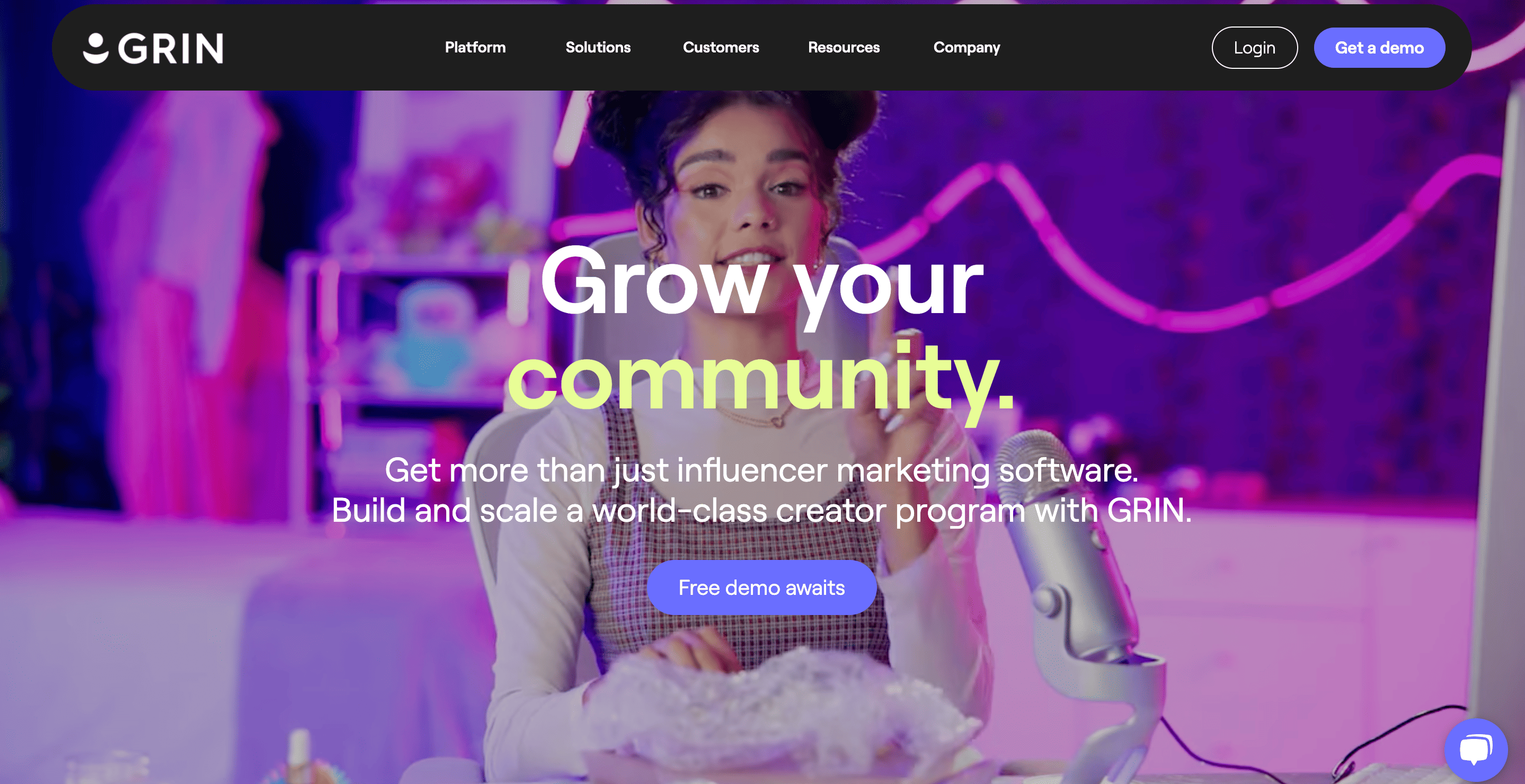
Platform Coverage: Instagram, TikTok, YouTube, X (Twitter), Twitch, Snapchat
Best For: GRIN is best for eCommerce and DTC brands looking to manage the full influencer lifecycle in one place, from product seeding and gifting to affiliate commissions, UGC collection, and ROI tracking. It excels with Shopify, WooCommerce, and PayPal integrations that streamline operations for product-focused teams
Pricing: Plans start at $25,000 per year, with monthly payments available and a required 12-month commitment; typical monthly costs range from $2,500 to over $10,000 depending on usage, though pricing transparency may vary based on selected features.
Reviews: 4.5 / 5.0 (G2)
Ease of Use (UX/UI): Users praise GRIN’s all-in-one dashboard that covers everything from outreach to gifting and performance analytics. The platform is efficient once set up, but users note that onboarding and learning the system can take time, especially for new teams unfamiliar with integrated workflows.
Customer Support: Support reviews are mixed. Many users value GRIN’s dedicated onboarding and strategic support options, but others report inconsistent follow-through and delayed ticket resolutions. Some mentioned frustration with being billed for unresolved features or facing long wait times for bug fixes.
Dreaminfluence is designed for brands looking for flexible, gifting-based campaigns with strong CRM management and content repurposing support. It includes first-party influencer data, AI-driven recommendations, and hands-on support from micro-influencers. Pricing starts around €810/month, making it more accessible to smaller teams and growing brands.
GRIN, on the other hand, is an end-to-end powerhouse for product-led influencer programs. With deep integrations into Shopify and WooCommerce, GRIN automates every step from product seeding to affiliate tracking. It’s best suited for high-volume eCommerce teams that prioritize performance metrics, integrated payments, and structured workflows.
Dreaminfluence begins at approximately €9,720/year with all features included. GRIN pricing starts around $25,000/year, with options from $2,500–$10,000/month depending on features.
Choose Dreaminfluence for agile influencer gifting campaigns with white-glove support, or opt for GRIN if you need robust infrastructure, performance tracking, and eCommerce-scale operations.
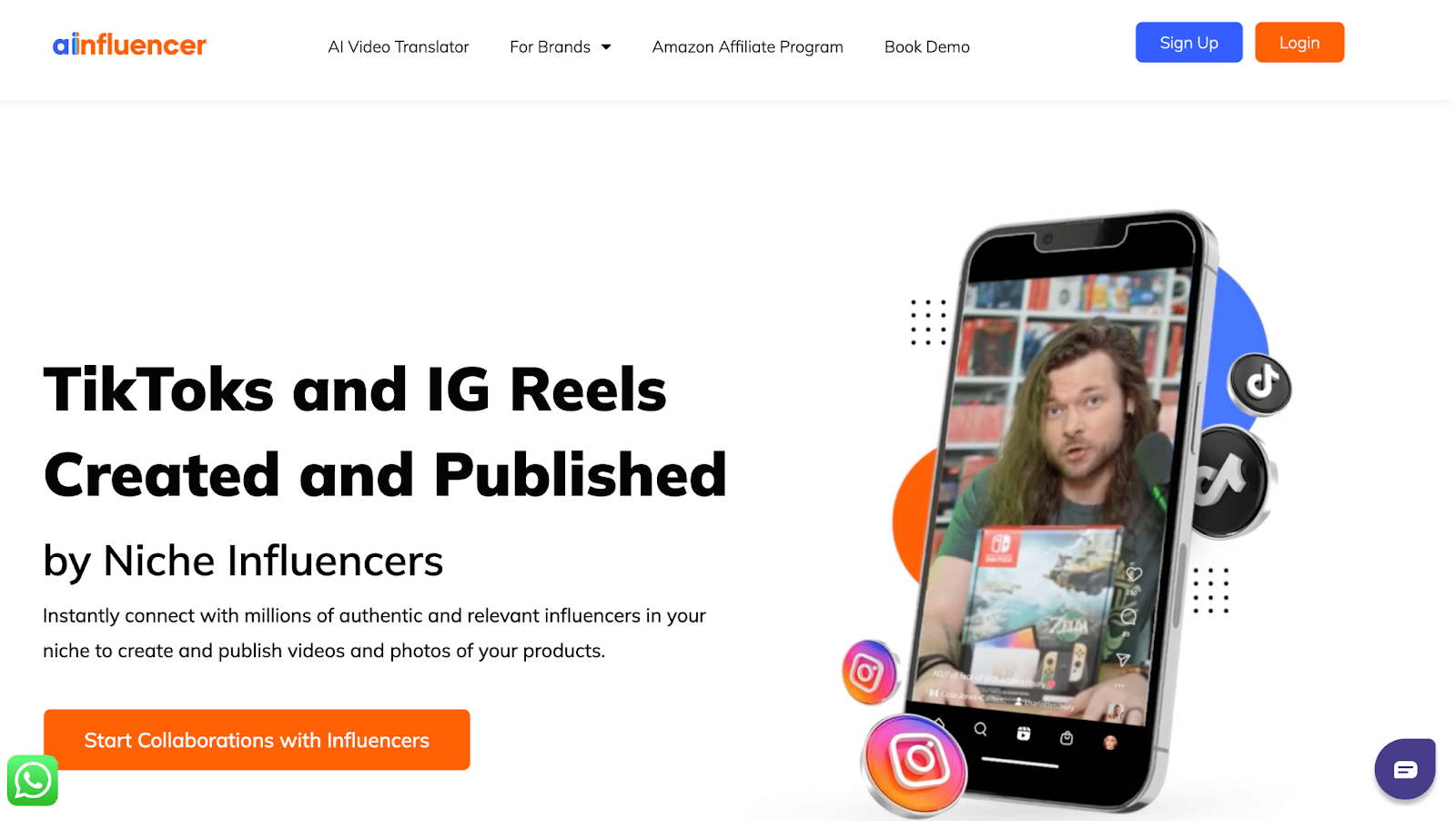
Platform Coverage: Instagram and TikTok
Best For: Ainfluencer is best for small to mid-sized brands looking for a cost-effective way to run influencer campaigns without long-term contracts or platform fees. It’s particularly attractive for teams looking to quickly scale Instagram or TikTok collaborations with minimal upfront investment.
Pricing: Free self-serve platform (no SaaS fees)
Paid campaign packages (optional):
Minimum influencer payment: $10 per post
Reviews: 4.4 / 5.0 (G2)
Ease of Use (UX/UI): Brands find Ainfluencer’s UI simple and mobile-first, especially effective for launching and managing campaigns quickly. However, its influencer discovery tools are relatively basic, with limited search and filtering options.
Customer Support: Users handling campaigns manually get access to onboarding resources and basic support. For managed campaigns, the Ainfluencer team handles outreach and execution, which is appreciated for its hands-off approach, though support quality may vary depending on the package.
Dreaminfluence offers detailed influencer tracking, first-party data, Shopify integration, and built-in affiliate capabilities, making it perfect for structured campaign workflows and brands prioritizing accurate reporting. Ainfluencer, by contrast, offers a lightweight and budget-friendly alternative.
With no software fees and an influencer marketplace of 5 million+ creators, it's excellent for small brands running quick TikTok or Instagram campaigns. Its escrow model adds a layer of protection for content delivery and payment, though tracking and insights are much more limited.
Dreaminfluence starts at €810/month with gifting, AI, CRM, and affiliate tools included. Ainfluencer is free to use manually, with managed plans starting at $7,999/month for 25 influencers.
Choose Dreaminfluence for scalable influencer infrastructure and long-term strategy, or pick Ainfluencer for affordable, campaign-based collaborations on TikTok and Instagram.
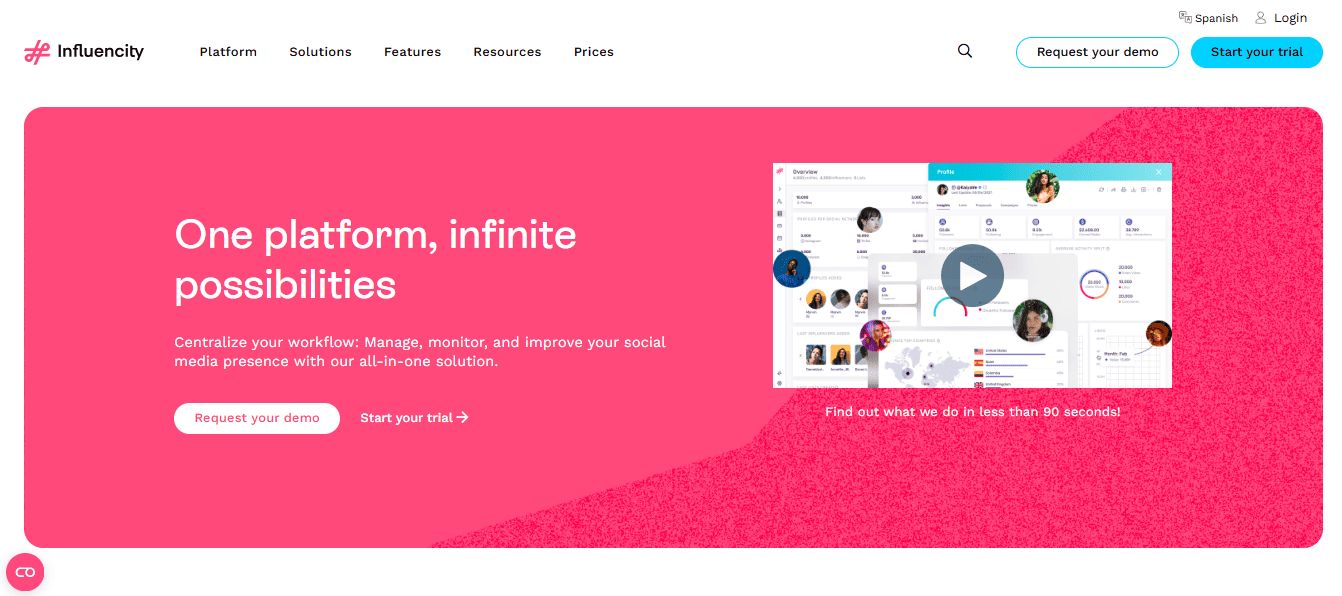
Platform Coverage: Instagram, TikTok, YouTube, Twitter (analytics only)
Best For: Brands looking to manage influencer campaigns end-to-end, particularly those who need efficient influencer discovery, CRM management, and detailed analytics. It's best for businesses seeking to scale campaigns across platforms like Instagram, TikTok, and YouTube.
Pricing:
Reviews: 4.4 / 5.0 (G2)
Ease of Use (UX/UI): Users appreciate Influencity's clean, functional design, especially for its intuitive interface that streamlines influencer management and campaign execution. However, some users report a steeper learning curve, particularly when using advanced tools for tracking and reporting.
Customer Support: Influencity offers comprehensive customer support through various plans. Support is responsive, with resources available to help with onboarding and campaign execution. Some users note that the onboarding process can take a few weeks, but once set up, ongoing support is efficient.
Dreaminfluence offers a more affordable pricing structure for smaller teams, while Influencity is more suited to larger-scale campaigns.
This platform is more geared towards gifting-based campaigns and offers a verified influencer pool of 18,000+ influencers, primarily focused in Europe. On the other hand, Influencity excels in its AI-powered influencer discovery, offering broader public data access (15M+ influencers) and extensive analytics. While Dreaminfluence is more focused on smaller, highly vetted influencer pools, Influencity caters to a larger, more diverse range of influencers worldwide.
Dreaminfluence’s plans start at €810/month (Growth) for up to 80 influencers, with a €1,350 onboarding fee. Influencity’s pricing starts at $3,816/year (Professional), offering up to 10,000 monthly search results and 150 profile unlocks.
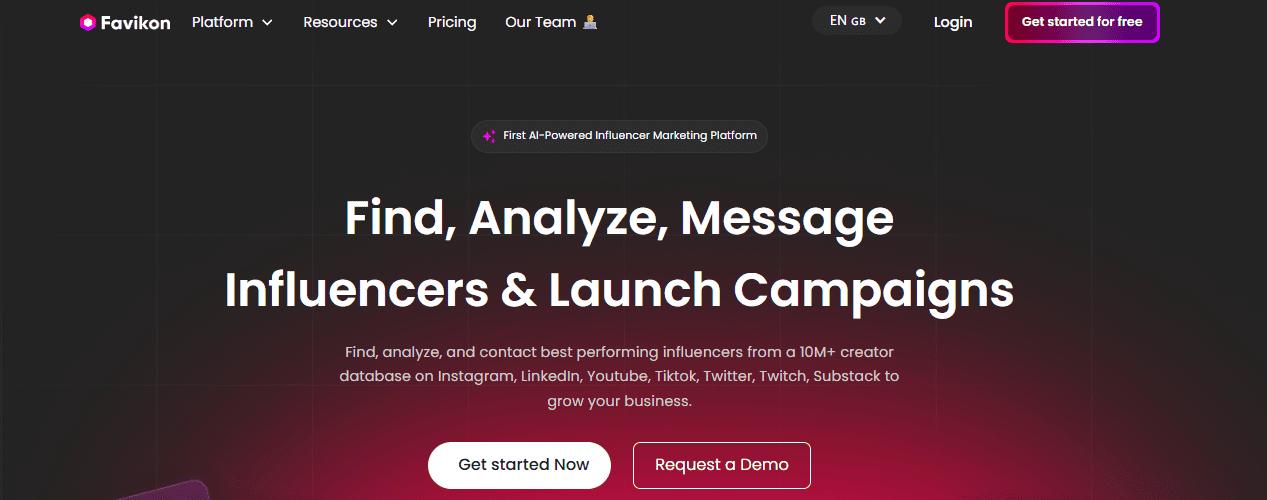
Platform Coverage: Instagram, TikTok, YouTube, LinkedIn
Best For: Favikon is ideal for data-driven brands that want to scale influencer collaborations across platforms like Instagram, TikTok, LinkedIn, and YouTube with precision. It is best suited for teams looking for AI-powered influencer discovery, robust CRM tools, and advanced analytics.
Pricing: Annual billing only; extremely affordable compared to most influencer platforms.
Reviews: 4.6 / 5.0 (G2)
Ease of Use (UX/UI): Users find Favikon’s interface intuitive, especially for advanced users, thanks to its seamless CRM integration and browser-based discovery. However, the depth of the data and tech features may feel overwhelming for smaller brands or those new to influencer marketing.
Customer Support: Favikon offers 24/7 chatbot support with all plans, and personalized onboarding for its Standard and Pro tiers. Users report that support is responsive, though some mention that due to the platform's complexity, more tailored support may be necessary for beginners.
Both Dreaminfluence and Favikon provide robust tools for influencer discovery and campaign management, but they cater to different needs.
Dreaminfluence focuses on a verified influencer pool and is ideal for brands looking for a gifting-based model with a high level of customer support. In contrast, Favikon shines with its AI-powered influencer discovery engine and integrated CRM, allowing brands to scale campaigns more strategically across multiple platforms, including LinkedIn. Favikon is better suited for data-driven brands or teams looking to handle the negotiation process directly with creators.
Dreaminfluence’s plans start at €810/month (Growth), offering up to 80 influencers, while Favikon offers plans starting at $69/year (Starter), with up to 5,000 creators discovered. Favikon’s pricing is more affordable for smaller businesses, while Dreaminfluence offers more hands-on support for mid to large-scale influencer campaigns.
In conclusion, finding the right Dreaminfluence alternative is essential for brands looking to streamline influencer marketing. While Dreaminfluence provides solid functionality, its limitations in affiliate tracking and real-time analytics push many users to explore other options.
Platforms like Influencer Hero stand out as a top alternative due to their comprehensive suite of tools, including influencer discovery, CRM management, affiliate tracking, and UGC integration, all within an intuitive platform designed for fast-growing D2C brands.Other platforms like Favikon also offer valuable features, such as AI-powered influencer discovery and a robust CRM system, which cater well to data-driven brands scaling their campaigns across multiple platforms.
Ultimately, the choice between Dreaminfluence and its alternatives depends on the brand’s specific needs. Influencer Hero, with its scalability and diverse features, emerges as one of the best alternatives for those looking for a more comprehensive and flexible solution.

Top alternatives include Influencer Hero, Traackr, Upfluence, Favikon, and GRIN. Influencer Hero is ideal for scalable solutions with features like influencer discovery, CRM, affiliate tracking, and UGC management, all in one platform.
Influencer Hero offers broader platform support (Instagram, TikTok, YouTube, Facebook) and advanced automation for outreach and CRM. It’s a more scalable solution for growing brands, while Dreaminfluence focuses on TikTok and Instagram with more manual workflows.
Favikon is more affordable, starting at $69/year, and offers AI-powered influencer discovery, CRM tools, and analytics. Dreaminfluence is better for brands focused on gifting-based campaigns, but comes at a higher price.
No, Dreaminfluence only supports Instagram and TikTok. If you need multi-platform support, alternatives like Influencer Hero, Upfluence, or GRIN offer broader coverage.
Influencer Hero and Traackr excel in reporting. Influencer Hero offers real-time tracking and ROI insights, while Traackr provides in-depth analytics and performance benchmarks across multiple platforms.



Schedule a Demo with one of our media experts below.